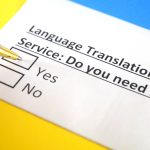
What is the Difference Between Translation and Transcription? A Comprehensive Guide
In the world of global communication, it’s critical to understand the difference between translation vs transcription — two linguistic services that may sound similar but serve very different purposes. For large enterprises dealing with international clients, multilingual documents, or cross-border collaboration, knowing when to use each can dramatically affect the success of your projects.
What Is Translation and How Does It Work?
Translation is the process of converting text from one language into another while preserving its original meaning, tone, and context. This service is essential for businesses seeking to localize documents, manuals, websites, contracts, marketing materials, or any other content intended for an audience that speaks a different language.
Translation is not a word-for-word replacement; it involves deep cultural and linguistic understanding. A high-quality translation ensures that idioms, technical terminology, and intent are accurately conveyed in the target language.
Translation and Transcription: Understanding the Process
The translation process typically follows a structured workflow:
- Source Text Review: A professional translator first reviews the source document to understand its purpose, audience, and technical requirements.
- Terminology Research: The translator compiles glossaries of industry-specific terms and consults client-provided style guides if available.
- Translation Execution: Using linguistic expertise and translation memory tools, the translator begins converting the content.
- Editing and Proofreading: A second linguist reviews the translation to ensure accuracy, tone, and formatting are consistent with the source text.
- Desktop Publishing (Optional): If the source document contains graphics or layouts (e.g., brochures or manuals), DTP specialists adjust the formatting for the translated version.
- Final QA: A final quality assurance check ensures the translation is linguistically and visually flawless.
Professional translation services often use CAT (computer-assisted translation) tools to improve consistency, reduce turnaround times, and maintain terminological accuracy.
What Is Transcription and When Is It Needed?
Transcription refers to converting spoken language (typically from audio or video files) into written form in the same language. It is widely used for interviews, legal depositions, academic lectures, business meetings, medical consultations, and multimedia content like podcasts or documentaries.
Unlike translation, transcription is monolingual—it captures what was said, verbatim or edited, and puts it into written text for archival, review, or publication.
Translation and Transcription: Understanding the Process
Here’s how the transcription process typically works:
- Audio/Video File Collection: The client provides the audio or video files to be transcribed.
- Audio Quality Check: The transcriptionist evaluates the clarity of the recording, speaker accents, background noise, and pace of speech.
- Initial Transcription: The transcriptionist listens to the recording and types out the spoken content. This could be:
- Verbatim Transcription: Every utterance, pause, and filler word is captured.
- Edited Transcription: Filler words, false starts, and redundancies are removed for clarity.
- Timestamping (Optional): Time markers may be added for easier reference, especially in legal or media contexts.
- Proofreading: The transcript is reviewed for accuracy, completeness, and formatting.
High-quality transcription requires active listening skills, language proficiency, and sometimes familiarity with industry jargon, especially in legal or medical settings.
Key Differences Between Translation and Transcription
Though both services deal with language, translation vs transcription can be clearly distinguished in purpose, input, and output. Here’s how they compare:
Understanding these distinctions is crucial when selecting the right service for your needs.
When to Choose Translation Over Transcription
The decision between translation and transcription depends on the nature of your source material and your objectives. Here’s when translation is the appropriate choice:
- You need to convert documents into another language: From product manuals to legal contracts, translation makes content accessible to international partners.
- Your audience speaks a different language: Whether localizing a website or preparing multilingual marketing content, translation ensures cultural relevance.
- You’re creating multilingual training or compliance materials: Avoid miscommunication by translating internal documents into the languages your employees understand.
- You’re adding subtitles to a foreign-language video: You’ll first need transcription (if it’s in the same language), then translation of that text into the target language.
In many corporate scenarios, especially those involving international operations, translation is vital for legal compliance, brand consistency, and customer engagement.
When to Choose Transcription Over Translation
On the other hand, transcription is the right fit when:
- You have interviews or focus groups to analyze: Transcripts make it easier to categorize and study spoken responses.
- You’re producing content for accessibility: Transcripts help hearing-impaired individuals access audio/video content.
- You need a record of meetings or hearings: Legal, academic, and corporate sectors often require accurate transcriptions for documentation and auditing.
- You plan to translate audio or video later: Transcription is often the first step before translating dialogue into another language.
In short, transcription preserves speech in written form, while translation transforms written meaning into a new linguistic framework.
Common Mistakes in Translation and Transcription
Despite their distinct roles, organizations often conflate or misuse these services. Avoid the following pitfalls:
1. Confusing the Two Services
Some assume that a transcriptionist can simply translate audio or that a translator can transcribe a video. However, these tasks demand different skill sets, software, and linguistic competencies.
2. Skipping the Transcription Phase
For video projects, skipping transcription before translation leads to inaccuracies. Having a clear transcript ensures better translated subtitles and scripts.
3. Relying on Auto Tools Alone
While AI-based tools can support transcription and translation, human oversight is essential for nuance, tone, and industry terminology, especially in regulated industries like legal, financial, or healthcare.
4. Ignoring Formatting and Localization
Translation isn’t just about changing words—it’s about adapting visuals, symbols, and formatting for the local market. Poor formatting can render a translated document unprofessional or even unusable.
5. Underestimating Time and Scope
Both services take time. Expecting a 3-hour audio file to be transcribed and translated overnight is unrealistic. Planning and budgeting for proper linguistic services ensures better results.
Choosing the Right Language Partner for Your Business
The distinction between translation vs transcription is more than academic—it directly impacts how your business communicates, complies, and connects across borders. When dealing with sensitive documentation, technical terminology, or high-stakes projects, selecting the correct service and provider can make or break your global strategy.
Why Choose Etcetera Language Group, Inc.
At Etcetera Language Group, Inc., we understand the complex linguistic needs of global businesses. Our multilingual team of certified professionals offers:
- High-quality document translation across dozens of languages
- Accurate desktop publishing (DTP) for professionally formatted content
- Industry expertise in legal, technical, medical, marketing, and more
- End-to-end support, from initial consultation to final delivery
With a proven commitment to precision, confidentiality, and service excellence, we serve large corporations looking for scalable, reliable, and culturally aware language solutions.
Ready to bridge language gaps and elevate your brand globally?
Contact us today to request a quote and learn how our translation and desktop publishing services can help your organization thrive in the international marketplace.
More...
Categorised in: Transcription, Translate, Translation Services





